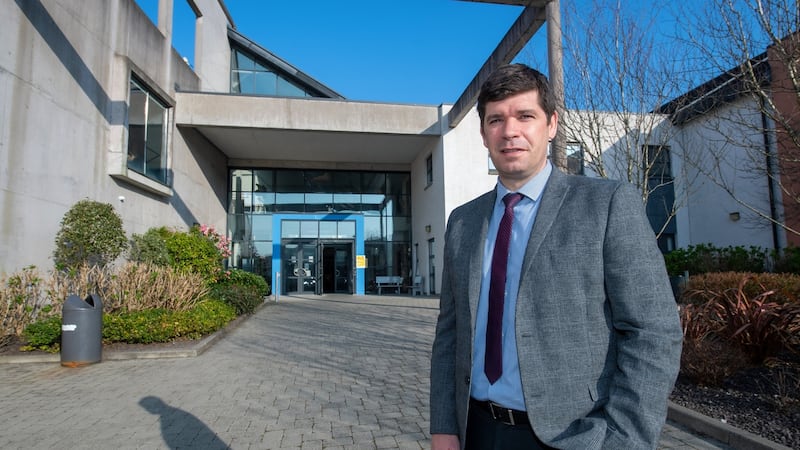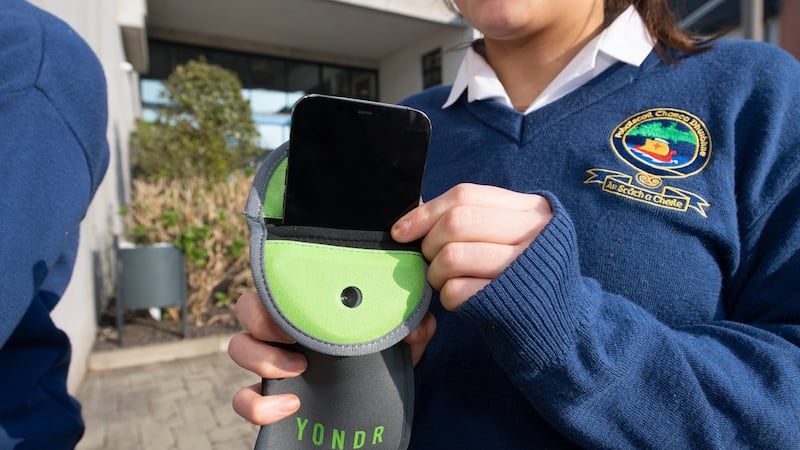In September 2021 while all schools were collectively navigating a restricted environment, populated with face masks, hand sanitisers and protective screens, Pobalscoil Chorca Dhuibhne in Dingle, Co Kerry was the first school in Ireland to introduce another type of screen restriction.
Principal Éamonn Fitzmaurice introduced the school to a magnetic pouch for a smartphone, which has transformed the school campus into a phone-free space without banning them.
Students place their phones in a pouch that locks on entry to the school. They carry the pouches but cannot access their phones during the school day unless specifically enabled by their teacher.
“It was a positive way of dealing with it rather than banning phones completely,” says Fitzmaurice.
The school favoured Yondr over an outright ban as they believed a ban would be too punitive.
“We didn’t want conflict around that, particularly for the students when they were coming back after a year and a half of Covid,” says Fitzmaurice. “We didn’t want to be adding another stressor to the menu of things that were there already.”
Fitzmaurice was spurred on to trial the system as he saw that the smartphone seemed to have a monopoly on how the students were interacting.
“Many of them would have been using them to listen to music and that kind of thing; they just weren’t interacting with each other,” says Fitzmaurice. “They were on their phones during break times, and they just weren’t present.
“We felt, from the positive point of view, that if we could educate them around reducing their screen time while they were at school, it would help to reduce it in general.”

We found that if there were notifications going off in a student's pocket, there was a natural curiosity there to wonder who was messaging and what it's about
Now the staff and children are noticing several changes filtering into the void where the phone used to be.
"There's just more interaction among the pupils, they're talking to each other more," says Fitzmaurice."They're having conversations rather than showing each other videos on WhatsApp or sitting looking at Instagram, they're actually just having the chats.
“Teachers have found that they’re more tuned in to the lesson because there isn’t that distraction, there isn’t that necessity of checking the notifications and trying to have a quick peek at their phone when the teacher turns their back,” says Fitzmaurice.
While concern over the impact of digital devices is nothing new, there is mounting evidence over the impact on students’ attention spans.
A study published in the US research journal Pediatrics – Media Multitasking and Cognitive, Psychological, Neural, and Learning Differences – highlights the potential impact smartphone use can have on academic performance.
The study indicates that smartphone use not only reduces accuracy and increases the length of time it takes to complete academic tasks, but “also has been reported to negatively impact the learner’s perceived ability to perform homework”.
Research also indicates that on average children were unable to stay focused on a task for more than six minutes before checking their social media or messages.
Fitzmaurice has seen this first hand: he says smartphones were distracting students during class time.
“We found that if there were notifications going off in a student’s pocket, there was a natural curiosity there to wonder who was messaging and what it’s about,” says Fitzmaurice.
“You’re not going to be concentrating on what’s going on in the class if someone has messaged you.”
Graham Dugoni, chief executive of Yondr, the company behind the mobile phone pouches, says the firm's goal in schools is to create a space where students can be free from social media for the day. He says previous generations experienced school in a different way.
“To grow up with a computer in your pocket is a fundamentally different way to experience the world. I think if we’re going to help this younger generation find their own way, let’s give them the chance to experience what it’s like to move through the world without that lens in between you and the rest of the world mediating social interactions,” says Dugoni.
Faye Greely, a sixth-year student at Pobalscoil Chorca Dhuibhne, tried to cut down on her smartphone usage prior to the school's new policy. She believes social media had a definite impact on her growing up.

At lunchtime now we all talk to each other, and no one is on their phone
“Social media shaped our view of what we’re supposed to look like,” says Greely. “It happened to boys too, but I think it’s worse for girls. I would love to go back in time and just tell myself to stay off social media.”
Greely says students were initially opposed to the idea of surrendering their phones during school hours but it didn’t take long for their position to change.
“It didn’t even take me a week to get used to it, it’s so much better. At lunchtime now we all talk to each other, and no one is on their phone,” she says.
Along with the increase in social interactions in the school, Fitzmaurice has also noticed a significant decrease in time spent managing phone-related discipline issues.
“We found in the office that you could be dealing with bullying issues from a phone that had happened outside of school,” says Fitzmaurice. “It could be quite complicated, particularly with the likes of Snapchat, where the messages disappear but now, in terms of the amount of stuff we’ve been dealing with in the office, it has hugely reduced.”
Issues around smartphone use are not confined to post-primary schools. With children getting phones at younger ages, these problems are seeping into the primary school years.
"It used to be very much a sixth-class thing, that they would get them for their Confirmation, or they get them at Christmas, but now we see a lot more of fourth and fifth class have them and a small number in third," says Kathryn Corbett, principal at Bishop Galvin National School, Templeogue.
Corbett says that while the children have their phones off during school time, she has observed the foothold smartphones have in the children’s lives outside of school.
“I’ve really noticed that on the way to school in the morning, the phones would be out, and when school is over it’s the first thing that they reach for,” says Corbett.
A report published by the ESRI also highlights the negative impact smartphones have on the academic development of children. It states that “children who already report owning a phone by the age of nine fare less well in terms of their academic development as they move into adolescence”.
For Corbett it is the access to social media that causes the greatest concern. “We’ve made it too socially acceptable for children to be on social media,” says Corbett. “The smartphone as a device would be great but it’s the social media aspect of it that distinguishes it from other devices.”
Corbett has also noticed the increase in smartwatches that puts phones on their wrists.
Managing your child’s smartphone behaviour as a parent can be a challenging space and feedback from parents at Pobalscoil Chorca Dhuibhne about Yondr has been overwhelmingly positive.
"When I heard about it, I wasn't sure, I didn't know how they were going to implement it," says Claire Greely, parent of two children attending the school. "I think they've done it successfully and now that we're used to it, we love it and I would imagine that all the parents do."
Digital distraction: in numbers
- 7.5 hours: Average time US youth spend on media per day
- 29%: Amount of this time spent media multi-tasking
- 20 minutes: Increased time taken to complete a 29-minute reading task when a student is instant messaging
- 6 minutes: Students studying, on average, switch to social media after about six minutes of focused work
Sources: Media multitasking and cognitive, psychological, neural, and learning differences, published in Pediatrics (2017); Causes, effects, and practicalities of everyday multitasking, published in Developmental Review (2015)











